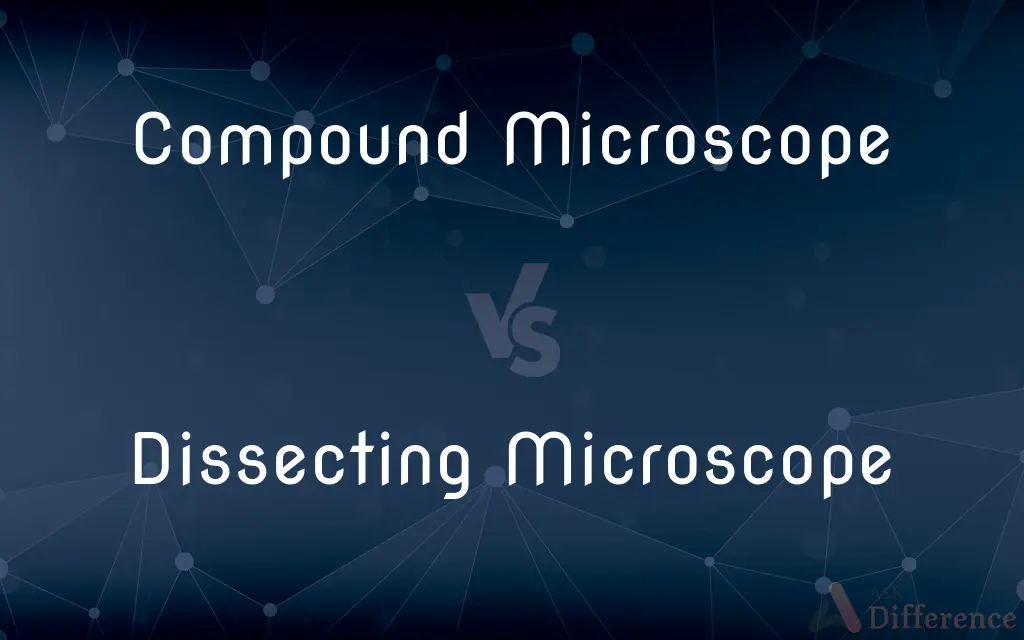Compound Microscope vs. Dissecting Microscope — What's the Difference?
By Tayyaba Rehman — Published on January 4, 2024
A Compound Microscope uses multiple lenses for high magnification of thin samples; a Dissecting Microscope provides low magnification for viewing surface details.

Difference Between Compound Microscope and Dissecting Microscope
Table of Contents
ADVERTISEMENT
Key Differences
A Compound Microscope is primarily designed for viewing thin samples, such as cell sections. The Dissecting Microscope, on the other hand, allows for viewing thicker, opaque specimens like plants or insects. Both instruments, while serving the purpose of magnification, cater to different research needs.
The Compound Microscope utilizes multiple lenses, which compound the magnification. Typically, it's equipped with a light source from below that shines through the specimen. Conversely, the Dissecting Microscope uses reflected light from above the specimen. This difference in light direction highlights the diverse applications of the two microscopes.
With a Compound Microscope, one can observe the minute details of a specimen, delving into cellular or even sub-cellular levels. In contrast, a Dissecting Microscope provides a three-dimensional, superficial view, making it perfect for examining the surface structures of larger specimens.
The specimens for a Compound Microscope are usually prepared on slides, made thin enough for light to pass through. For a Dissecting Microscope, no such preparations are typically necessary since the focus is on external details, and it can handle the thickness of most specimens.
While both the Compound Microscope and the Dissecting Microscope are invaluable tools in biology and research, they serve different magnification needs. The former delves deep into microscopic worlds, while the latter grants a closer look at the macroscopic realm.
ADVERTISEMENT
Comparison Chart
Magnification
High (typically up to 1000x or more)
Low (typically up to 100x)
Light Source Direction
Below the specimen
Above the specimen
Sample Type
Thin samples (e.g., cell sections)
Thicker, opaque specimens (e.g., insects, plants)
View
Two-dimensional, detailed
Three-dimensional, surface-focused
Typical Use
Cell biology, microbiology
Entomology, botany, surface examination
Compare with Definitions
Compound Microscope
A microscope with an objective and an eyepiece lens.
Adjusting the focus on the Compound Microscope, he could see the organelles.
Dissecting Microscope
Uses reflected light to view specimen surfaces.
With the Dissecting Microscope, the surface details of the leaf were evident.
Compound Microscope
Used mainly in biology and medical labs.
The lab technician depended on the Compound Microscope for accurate diagnoses.
Dissecting Microscope
Provides a three-dimensional perspective.
The Dissecting Microscope revealed the intricate details of the flower's anatomy.
Compound Microscope
A microscope with multiple lenses for high magnification.
The biologist used a Compound Microscope to observe the bacteria.
Dissecting Microscope
Ideal for observing larger, opaque objects.
He chose the Dissecting Microscope to examine the rock's texture.
Compound Microscope
A tool for viewing thin, translucent specimens.
With the Compound Microscope, cellular structures became clearly visible.
Dissecting Microscope
Commonly used in botany and entomology.
During her fieldwork, she always carried a Dissecting Microscope to inspect plants.
Compound Microscope
An optical instrument using transmitted light.
She placed the slide under the Compound Microscope to view the cell details.
Dissecting Microscope
A microscope designed for low magnification viewing.
The entomologist used a Dissecting Microscope to study the insect.
Common Curiosities
Which microscope gives a three-dimensional view?
The Dissecting Microscope provides a three-dimensional perspective of specimens.
What is the main purpose of a Compound Microscope?
A Compound Microscope is used for viewing thin samples at high magnification, such as cell sections.
Can you view live insects with a Compound Microscope?
Typically, live insects are better viewed with a Dissecting Microscope due to their size and opacity.
How is a Dissecting Microscope different in terms of magnification?
A Dissecting Microscope offers lower magnification, typically up to 100x, ideal for viewing surface details of specimens.
Why do Compound Microscopes need thin samples?
Thin samples allow light from below to pass through, enabling clear magnification.
Which microscope would a botanist prefer for plant examination?
A botanist might prefer a Dissecting Microscope for examining the external structures of plants.
Can you view cells with a Dissecting Microscope?
Cells are better viewed with a Compound Microscope due to the need for higher magnification.
Is the light source different between the two microscopes?
Yes, Compound Microscopes use transmitted light from below, while Dissecting Microscopes use reflected light from above.
Are both microscopes used in medical research?
While Compound Microscopes are more common in medical labs, Dissecting Microscopes might be used for larger specimen examination.
Why is the term "compound" used for the Compound Microscope?
The term "compound" refers to the microscope's use of multiple lenses to achieve magnification.
How many lenses does a Compound Microscope typically have?
A Compound Microscope has multiple lenses, including an objective and an eyepiece lens.
Do you need to prepare slides for a Dissecting Microscope?
No, slides are typically not necessary for specimens under a Dissecting Microscope.
Which microscope is better for viewing surface textures?
The Dissecting Microscope is ideal for examining surface textures.
Can you observe bacteria with a Dissecting Microscope?
Bacteria are too small for a Dissecting Microscope and are best viewed with a Compound Microscope.
Is a Dissecting Microscope suitable for examining cellular details?
No, a Dissecting Microscope focuses on surface details rather than cellular structures.
Share Your Discovery

Previous Comparison
GPS vs. DGPS
Next Comparison
C# List vs. C# ArrayAuthor Spotlight
Written by
Tayyaba RehmanTayyaba Rehman is a distinguished writer, currently serving as a primary contributor to askdifference.com. As a researcher in semantics and etymology, Tayyaba's passion for the complexity of languages and their distinctions has found a perfect home on the platform. Tayyaba delves into the intricacies of language, distinguishing between commonly confused words and phrases, thereby providing clarity for readers worldwide.
















































